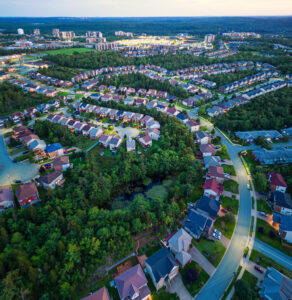
Bubble Contagion? Eastern Canada Home Prices Retain The Frothiest Growth
The comments below are an edited and abridged synopsis of an article by Stephen Punwasi, Better Dwelling
Following rate cuts, Canadian real estate prices experienced a surge, but have since moderated as rates normalized, according to data from the Canadian Real Estate Association. The composite benchmark, reflecting a typical home, rose following rate cuts in March 2020, reaching its peak as rates started to normalize in 2022. However, Eastern Canada stands out as an exception, with home prices not only seeing the largest increase after rate cuts but also undergoing only a minimal correction as rates began to rise, maintaining their status as the region with the most pronounced growth nationwide.
Examining the national composite benchmark provides insight into the market dynamics. Canadian real estate prices reached their peak in March 2022, with the typical home valued at $855,800, marking a 54.8% increase since the onset of rate cuts in March 2020. Subsequently, prices corrected, though they remained 32% higher than the starting point, with a benchmark price of $729,700 as of March 2024. This demonstrates a significant fluctuation over a 2-year period, with peak growth occurring exactly two years prior, followed by a substantial reduction in growth over the subsequent two years.
Eastern Canadian provinces notably experienced the most vigorous growth across the country. From March 2020 to their respective peaks, home prices surged the most in Nova Scotia (+71.7%), New Brunswick (+70.3%), and Prince Edward Island (+66.1%). These markets reached their peaks shortly after rates began to rise, within three months of the initial hike in 2022. Additionally, after the first rate increase, credit conditions did not undergo a significant deterioration, indicating a high probability that this growth was largely driven by exuberance, akin to the effect observed in Ontario’s cottage country.
Despite declines from their peak levels, Eastern Canada continues to lead in terms of growth. From March 2020 to March 2024, the same three provinces retained their positions for the highest price growth, albeit with a reordering. New Brunswick exhibited the highest growth (+69.4%), followed by Nova Scotia (+60.4%) and PEI (+59.3%). These provinces experienced minimal corrections in their prices, at least for the time being.
In contrast, Canada’s two most expensive markets had distinct trajectories over the past four years. From 2020 to their peaks, Ontario (+64.4%) outperformed the national benchmark, while British Columbia (BC) (+51.6%) slightly underperformed, though it remains Canada’s priciest market. However, unlike the Eastern Canadian provinces, these markets witnessed significant declines as rates normalized. As of March 2024, growth from 2020 had been notably reduced in both Ontario (+35.2%) and BC (+37.5%), with Ontario experiencing a double-digit correction rate. While expensive regions like BC and Ontario are often associated with rapid growth, the robust growth observed in Eastern Canada prompts considerations of its justification. This trend resembles what experts term “bubble contagion,” where a region commands increasingly higher prices solely due to its relative affordability. Such bubbles tend to disregard factors like income growth and amenities, focusing instead on exuberant buyers and investors seeking to capitalize on available financing options.

